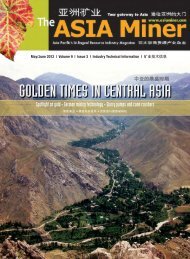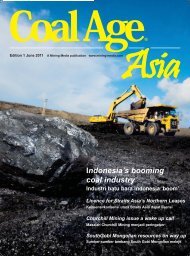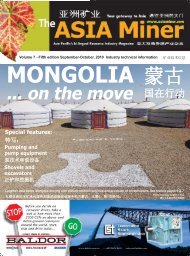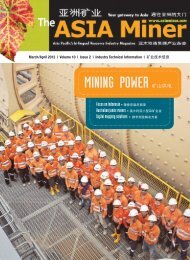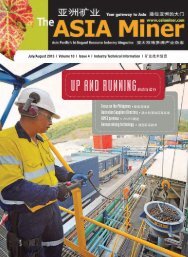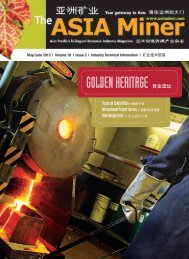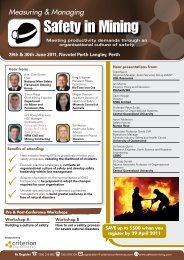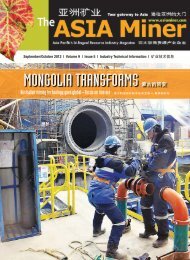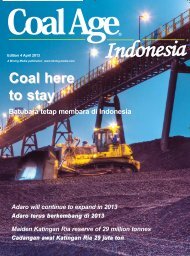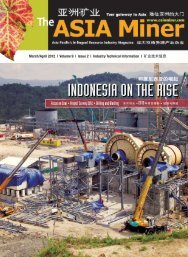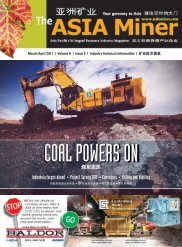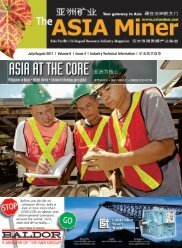MINING WELCOME 欢迎采矿 - The ASIA Miner
MINING WELCOME 欢迎采矿 - The ASIA Miner
MINING WELCOME 欢迎采矿 - The ASIA Miner
You also want an ePaper? Increase the reach of your titles
YUMPU automatically turns print PDFs into web optimized ePapers that Google loves.
Philippines<br />
First nickel from Acoje pilot plant<br />
THE first nickel has been produced at ENK’s<br />
pilot plant on Luzon Island in northern Philippines.<br />
About 50kg of nickel hydroxide product<br />
(NHP) was released from the filter press,<br />
with initial assays showing the product contains<br />
about 49% nickel and 4% iron.<br />
<strong>The</strong> plant is about 250km north of Manila<br />
and can produce about 200kg of NHP each<br />
month using ion exchange to separate and<br />
purify the nickel and cobalt. <strong>The</strong> initial NHP is<br />
being sent to potential off-takers for evaluation.<br />
It has wide market appeal due to significantly<br />
low metal impurities.<br />
ENK’s managing director Robert Gregory<br />
says, “It is a magnificent effort by the Acoje<br />
team to go from being on care and maintenance<br />
last year to building and commissioning<br />
the pilot plant 10 months later.”<br />
ENK has two deposits on Luzon Island,<br />
with a combined JORC estimate of 840,000<br />
tonnes. <strong>The</strong> company hopes to use its lowcost<br />
heap leach process to extract nickel laterites<br />
at both the Acoje and Zambales<br />
chromite deposits.<br />
<strong>The</strong> company has demonstrated the percolation<br />
and extraction of nickel at its largescale<br />
demonstration plant at Çaldag in Turkey<br />
with continuous operations over a three year<br />
period. At this flagship project, ENK irrigates<br />
the heaps with dilute sulphuric acid, producing<br />
saleable mixed hydroxide product from<br />
<strong>The</strong> pilot plant and research facility at ENK’s Acoje<br />
Nickel Project.<br />
the downstream precipitation plant. Recoveries<br />
of 72% have been used in the Çaldag<br />
bankable feasibility study (BFS) for both nickel<br />
and cobalt. However, this mixed hydroxide<br />
product (MHP) has a higher level of metal impurities<br />
than the NHP produced from the pilot<br />
plant. Test work on an atmospheric pressure<br />
tank leach (ATL) in China is also continuing<br />
with encouraging results to date. ATL is an alternative<br />
leaching process to heap leaching<br />
and the company hopes test work on this<br />
system will help it to decide which leaching<br />
process will be taken forward to the Acoje<br />
BFS, which remains on track for completion<br />
by June 2012.<br />
ENK has started a comprehensive drilling<br />
program on the nearby Zambales Chromite<br />
Mining Corporation (ZCMC) tenement, which<br />
is about 5km north of Acoje and 250km north<br />
of Manila. It is owned 40% by ENK and 60%<br />
by an associated entity, Montemina Resources<br />
Corporation, and contains a JORC<br />
inferred resource of 23.5 million tonnes of<br />
nickel laterite ore at a grade of 1.18% nickel<br />
and 0.05% cobalt.<br />
<strong>The</strong> drill program of 255 holes totalling<br />
about 3000 metres is designed to provide infill<br />
drill data to upgrade the limonite estimate<br />
to indicated status as well as provide sufficient<br />
data to estimate an indicated resource<br />
for the untested saprolite horizon. <strong>The</strong> company<br />
expects the saprolite horizon will be<br />
similar Acoje where the saprolite could make<br />
up at least 50% of the total resource. Drilling<br />
will continue until the end of the first quarter.<br />
Joint venture for iron sands development<br />
ASTRA Far East, a subsidiary of Astra Resources,<br />
has signed a joint venture agreement<br />
with Cagayan River Construction & Development<br />
Corporation (CRCDC) to dredge, develop<br />
and manage iron sands reserves in the<br />
Cagayan River Delta and off-shore in northeast<br />
Luzon. Geological studies and extensive sampling<br />
suggest that at dredging depths of 14<br />
metres, well above 9 billion tonnes of iron<br />
sands are available with iron grades between<br />
27 and 59% with an average of 46%.<br />
<strong>The</strong> operation will be fully mechanized from<br />
river/sea bed preparation through to suction<br />
and discharge to barges. <strong>The</strong> project is expected<br />
to be supervised by dredging experts.<br />
Once dredged, the magnetite sands will need<br />
to be washed and separated and production<br />
of 60%-plus iron sands for export is expected<br />
to result from 30 to 60% of the sands, depending<br />
on the layers to be dredged.<br />
<strong>The</strong> Astra Group will maintain a super-majority<br />
of the joint venture entity in terms of equity<br />
and profit share entitlement, and is<br />
subject to Astra providing bond finance facilities<br />
for development and operation.<br />
Astra’s CEO Jaydeep Biswas says the<br />
dredging, developmental and mining permits<br />
currently allocated to CRCDC have now been<br />
assigned to the benefit of the joint venture.<br />
“Third party reports including geological studies<br />
from CRCDC have been positive, indicating<br />
that the area is an established producing<br />
region that exports to nearby steel manufacturing<br />
markets in China, Korea and Taiwan.<br />
“CRCDC has signed a memorandum of<br />
agreement with a provincial board in the<br />
Province of Cagayan, allowing the dredging<br />
of the delta with the responsibility to dispose<br />
of the sand metal content and residue. <strong>The</strong><br />
unusually high grade iron content is disposable<br />
through export and the residue is recyclable<br />
into other construction uses.”<br />
Astra’s managing director Silvana De Cianni<br />
says, “For the specific purpose of disposing<br />
the sandstone waste and residue, and marketing<br />
the processed iron component of the<br />
sands, a separate subsidiary with Astra at the<br />
helm shall be incorporated in Hong Kong.”<br />
<strong>The</strong> iron sands project is expected to supply<br />
Astra with a significant potential export<br />
business to some of the largest steel producing<br />
markets, with a key advantage of the project<br />
being its close proximity to China, the<br />
world’s largest iron ore importer.<br />
Additional geological work and feasibility<br />
studies are being conducted in the area prior<br />
to finalizing the funding from bond financiers.<br />
January/February 2012 | <strong>ASIA</strong> <strong>Miner</strong> | 45



